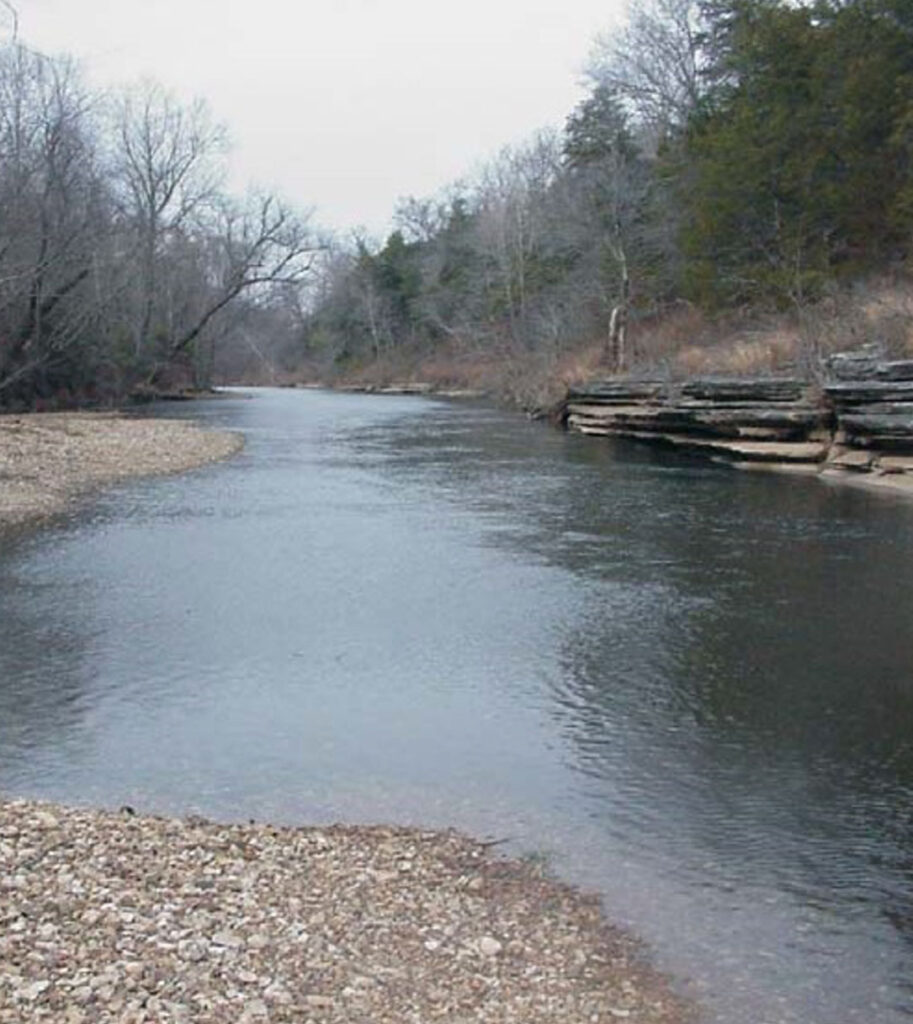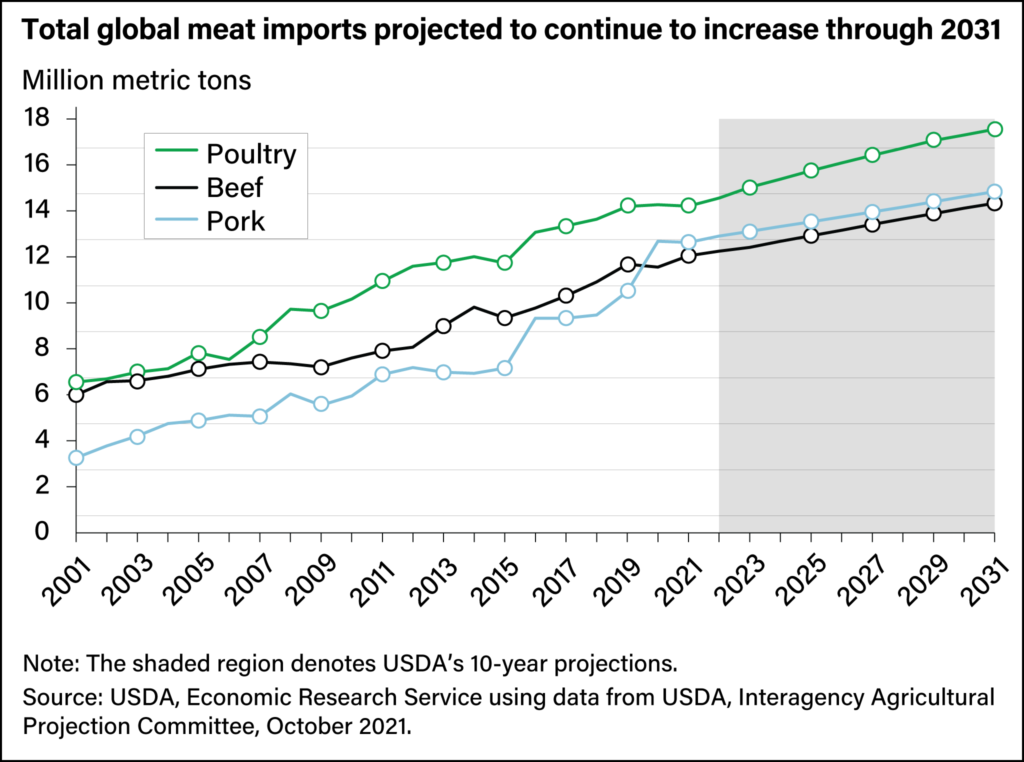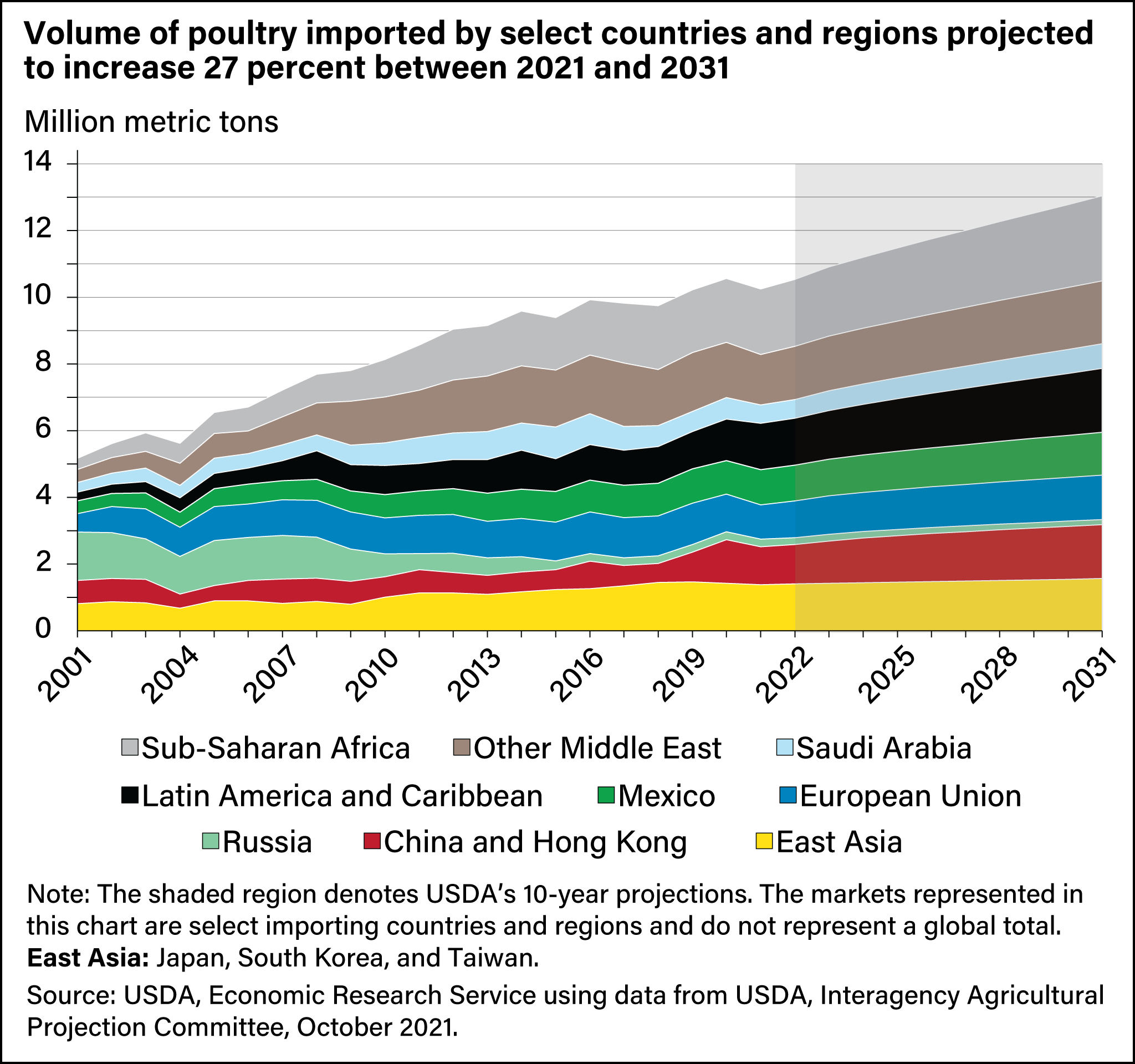In the United States, poultry is a major source of agricultural income. In 2023, according to the National Agricultural Statistics Service, the combined value of production from broilers (64 percent), eggs (27 percent), and turkeys (9 percent) contributed $80 billion to the economy.
USDA-Economics, Statistics and Market Information System – Poultry Production and Value
U.S. Leadership and International Influence
In 2023, the U.S. exported 4 million metric tons of poultry meat, worth $5.49 billion U.S. dollars. This represented 15 percent of the U.S. broiler production. Exports to Mexico were the largest at 23 percent followed by 15 percent to China and Hong Kong. Canada was the third largest import market for poultry meat from the U.S. Considerable import growth from the U.S. was also seen in Taiwan, Cuba Guatemala and the Philippines. Turkey exports for 2023 were 455 million pounds, with Mexico being the number one importer of turkey products.
Total table egg production amounted to 7.8 billion dozen in 2023. Egg exports amounted to 90 million dozen. Mexico, Canada, Japan, Jamaica and the European Union imported 74 percent of the U.S. exports. Domestic egg consumption increased per capita to a total of 279.3 per year. The consumption of broiler products per capita reached a high of 99.5 lbs. in 2023.
With the export and domestic use of poultry and turkey products, the United States is a major leader in poultry production worldwide.
US Poultry and Egg Export Council

Responsible Co-products Management — the Environmental Challenge
Such impressive growth and economic impact are accompanied by an additional yearly legacy. Every increase in poultry production increases the production of manure, used litter, carcasses, and the flow of wastewater from hatchery, egg, layer, and live-bird processing operations. These co-products must be safely disposed of, or used, to ensure that they do not lead to air or water pollution. The challenge for the industry is where and how to use these poultry co-products to benefit the poultry grower and protect the environment.
The rapid growth of the poultry industry internationally only augments the challenge, as does the clustering of poultry operations near food processing plants or large urban markets. The problem is simple to explain, but not so easily solved.
The traditional use for poultry co-products is land application, but land resources are not always sufficient.
Expanded or new uses for poultry co-products must continue to be sought after: for example, poultry co-products can and have been used as an ingredient in organic fertilizers, as a horticultural and mushroom growing medium, and as an ingredient in feed products for livestock, dogs, cats, and aquaculture. Indeed, a continuing search for additional uses is part of the challenge of modern production methods.
The poultry industry is committed to protecting water and air quality, the environment and natural resources. Growers in particular share responsibility with other segments of the agricultural community and all citizens for nonpoint source pollution: the pollution that originates from diffuse sources (e.g., agricultural runoff, urban stormwater runoff, and erosion). Some segments of the poultry industry may also contribute to point source pollution: the pollution that issues from a known or direct discharge (e.g., wastewater discharged from the end of a pipe or discharges from processing or treatment plants).
Understanding the complexity of poultry operations can help us address these potential water quality and environmental issues. The industry is separated into hatchery, breeder, broiler, turkey, egg, duck, and other poultry and live-bird processing operations. Each of these operations produces dry or liquid co-products and dead birds. In the past decade, environmental awareness has progressed beyond live-bird processing plants (offal, feathers, and wastewater) to focus on growers. The shift reflects an increasing awareness of how agricultural runoff affects water quality. It also recognizes that the growth of the industry (and its concentration in certain regions) elevates the need for increased awareness and management of on-farm environmental management.
An Outcome of Modern Production Methods
As any poultry grower knows, the speed, efficiency, and methods used to produce poultry and poultry products have changed drastically during the last 25 years as growers applied mass production techniques to farming operations and brought the benefits of information technology to the farm. As a result, most poultry are grown in confined operations with a limited environmental footprint. These conditions and changes in scale of production require each producer to dispose of or use immense quantities of co-products.
Any co-products, improperly handled, can pollute the environment. In this respect, poultry operations are no different from other human activities, and though each operation is unique, most if not all of the problems can be prevented or solved through proper co-products disposal or utilization methods and changes in management style or production techniques. The solutions are not uniform as each operation is different. Still, each one will begin with a model, a technology, or a case history that others can apply and adapt to their own situations.
It is important for growers to know at the beginning of the production cycle: (1) how much co-products will result from their operations; (2) how they can measure its chemical and physical make up; and (3) how they can account for its potential impacts on water quality, the environment, and human health. In addition, growers must know (4) how and when such impacts will occur, and (5) what measures they can take to prevent these impacts and manage the co-products in an environmentally safe manner.


Figures 1 and 2: Over the past two decades, poultry has become the most consumed livestock commodity in the world.
The overriding environmental issue facing growers today is to prevent poultry co-products from adversely affecting water and air quality. Potential water pollutants from on-farm poultry operations can be classified as (1) nutrients and salts, (2) organic materials, (3) bacteria, and (4) viruses. Potential air pollutants are dust and volatile organic compounds [gases], and nuisance odor.
These on-farm pollutants may originate in manure, litter, or dead birds. How such co-products are disposed of, treated, or managed will directly influence the cleanliness and safety of surface and groundwater resources. Air quality may also be affected by improperly handled poultry co-products. Air and soil are less obvious but no less important media for transporting these pollutants into the environment.
Disposing of spent hens (breeders or table egg layers after their production cycle) and dead birds is an increasing problem. The daily numbers and volume of dead birds will be predicated on the birds’ age and weight, the number of birds in the poultry house, and climatic conditions. Acceptable methods of disposal include (1) composting, (2) incineration, and (3) rendering. Incineration has some limitations, including the possibility of air pollution and increased fuel and labor costs.
Many progressive growers have switched to composting or to rendering as preferred solutions from an environmental and economic viewpoint. A grower must choose a method compatible with his or her individual operation and company preference. Dead birds must be treated as a resource that can add value to a grower’s operation. Improper methods of disposal are unacceptable and cannot be condoned, because of potential for air and water pollution and lapses in biosecurity.
The magnitude of the problem underscores the advantage to be gained from its alternative: namely, that properly managed poultry co-products from manure, litter, dead birds, and wastewater are profitable farm investments. An effective co-products management plan provides for the proper collection, storage, handling, and use of poultry co-products. Products derived from the materials will reduce chemical fertilizer costs, improve soil quality, and protect water resources, air quality, and human and animal health. Effective co-products management will also promote a favorable public attitude toward the industry.
There is not a single best or optimal approach to protect or preserve air and water quality and the environment. Good co-products management practices are essential if the poultry industry is to continue to grow and thrive under today’s environmental and societal challenges. The remainder of this handbook relates to the concern, management, and utilization of poultry co-products. Information on these topics provides management “guidance” to help poultry producers make sound environmental decisions; additional fact sheets discuss other environmental issues and alternative technologies. Sources of assistance are also compiled into resource and weblink archives.

Improper methods of disposal are unacceptable and can cause potential air and water pollution impairments and lapses in biosecurity.
In general, environmental needs and solutions are site-specific and regional in nature. Local sources of information, including industry associations, appropriate state agencies, soil and water conservation districts, and the USDA Natural Resources Conservation Service and Cooperative Extension Service offices, should be consulted to ensure that your co-products management plan complies with all state and federal regulations.
Producers using this handbook are encouraged to seek assistance from local, state, and federal agencies, private consultants, and other professionals on how to implement co-products management techniques that protect air and water quality and the environment. Water quality regulations and emerging air quality restrictions and permitting requirements vary from state to state and may be more stringent than national regulations.
References
Agricultural Marketing Service, 2024. U.S. farm income and wealth data product. USDA Agricultural Marketing Service, Des Moines, IA.
Economic Research Service, 2024. Livestock, Dairy and Poultry Outlook. LDP-M-359. USDA Economic Research Service, Washington, DC.
Narrod C. and C. Pray. 1993. Technology Transfer in the Poultry Industry: Factors and Externalities Associated with Increased Production. Pages 523-532 in Kenneth Steele, ed. Animal Co-products and the Land-Water Interface. CRS Lewis, Publishers, Boca Raton, FL.